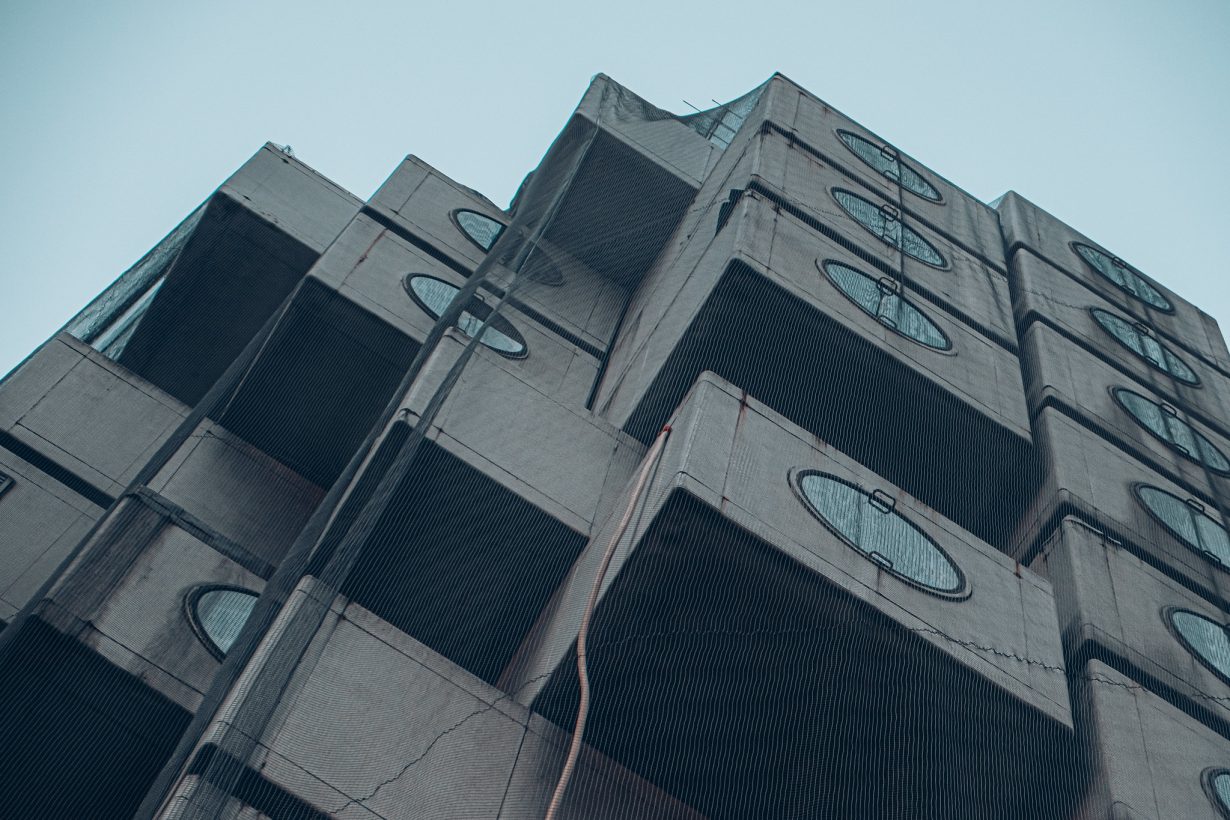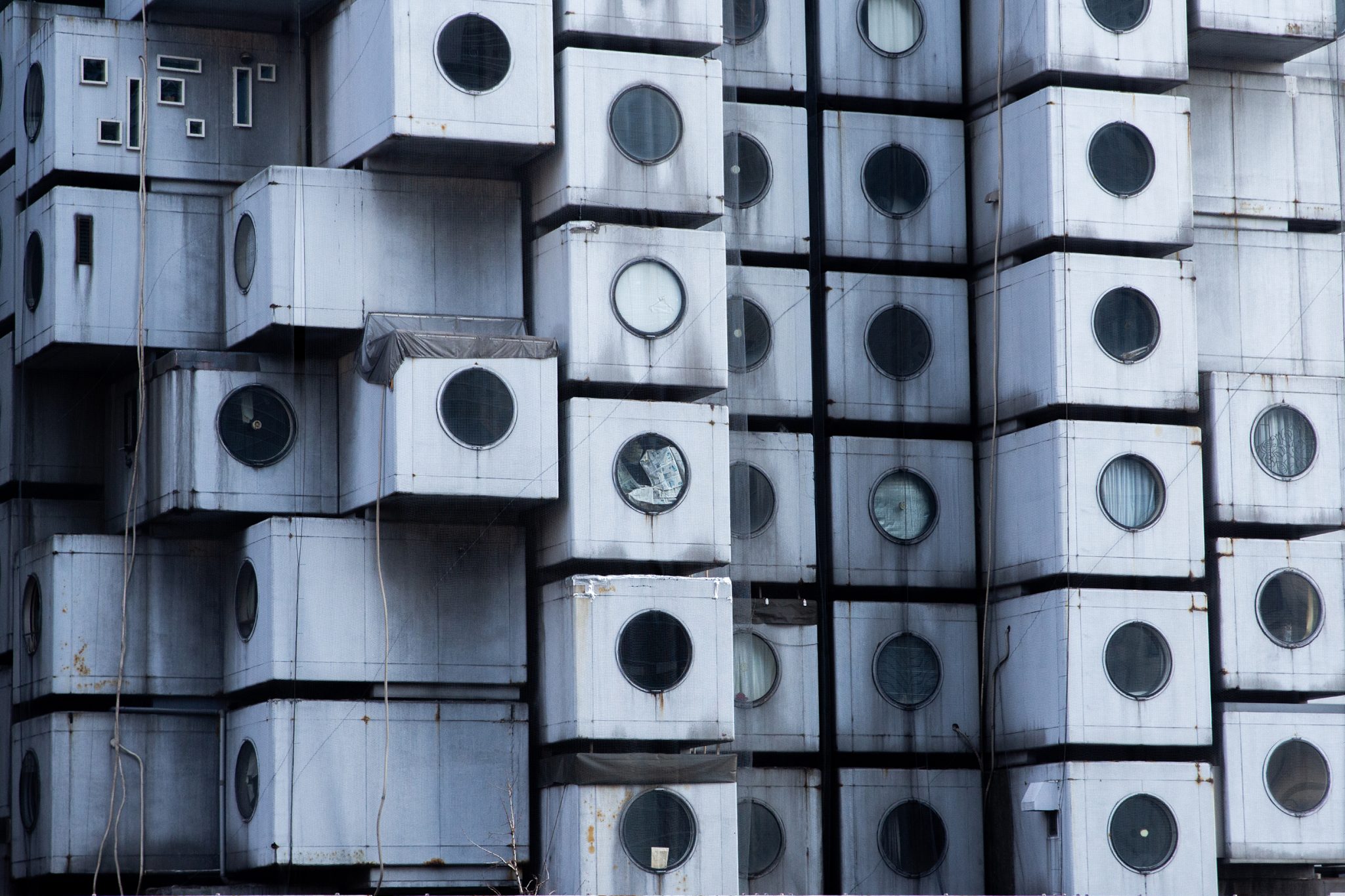‘A retrofuturist relic of a utopia that never came to be’
The demolition of one of Tokyo’s most iconic buildings is currently under way. Designed by Kisho Kurokawa, the Nakagin Capsule Tower was an intriguing oddity, a retrofuturist relic of a utopia that never came to be. It was a key architectural project of Japan’s postwar Metabolist movement, one of a minority of their extraordinary proposals that were built. To some, it was a garish blight on the cityscape, a kind of chaotically stacked vertical laundromat. To others, it was an innovative characterful proposition of a different way of living, as playful and committed as a childhood game. Beyond questions of taste, the rise and fall of the Nakagin Capsule Tower offers us a lesson of what happens when the future, so easily fantasised about or hubristically planned, actually arrives.
The Metabolists were a group of young architects (Kurokawa, Fumihiko Maki, Kiyonori Kikutake, Masato Ohtaka and others) in the 1950s and ’60s, who gathered around one of the leading modernists of the age, Kenzō Tange. Inspired by his philosophy, which connected urban design to the systems of the natural world, they published their manifesto Metabolism: The Proposals for New Urbanism, full of epic and seductively optimistic proposals, in 1960. They would become one of the more rigorous threads of a global experimentalism then emerging in architecture.

For all their internationalism, and their reinvention of influences from Le Corbusier to Yona Friedman, the Metabolists were unmistakably a Japanese phenomenon. At first, they called themselves the Charred Ruins School in reference to the devastation the Second World War had left in their country. Yet the ‘make it new’ ethos they embodied had deep and acknowledged roots in Japanese tradition. The Nakagin Capsule Tower is a case in point, with its round windows (as well as ‘absolute asymmetry’) deriving not from portholes but from the marumado windows of tea-rooms and temples. Their intention, however exuberantly-modern their constructions appear, was always to renew the Japanese vernacular, taking direct inspiration from the Ise Grand Shrine, which is both ancient and young, having been dismantled and rebuilt every twenty years for over a millennia. The Metabolists connected this to the idea of shinchintaisha (from which their anglicised name emerges), comparing the urban fabric to systems found in the natural world, and how they grow, develop and replace. Tinged with Marxist thought, this cellular view informed the social aspect to Metabolism, particularly the relationship of the citizen to the city and vice versa. It was not enough to see a building or a city as an organism, it was also a series of transformations, with every process and component being important in ‘a continuous development from atom to nebula.’

Just as the physics of the very small (Quantum mechanics) and the very large (the General Theory of Relativity) have so far proven irreconcilable, the Metabolists soon ran into difficulties bridging the atom and the nebula, the citizen and the city. With each capsule being plugged in to a core structure, the rooms of the Nakagin Capsule Tower could be replaced and recycled, offering a new prefabricated modular approach to building while also embodying the ancient Japanese concept of mono no aware, or the transience of all things. The problem, common to many ingenious modernist plans, was that the instructions were not adhered to. The capsules were not replaced, and nothing dates quite like the future. For all the claims of metamorphosis, the structure and its built-in features aged quickly, and became synonymous not with change but fixity and obsolescence, a curiosity embalmed in an outdated era.
There was a deeper issue though than mere mismanagement. It lay with Metabolism itself. Connecting urbanism to biological or botanical systems and cycles, joining Metabolism to metabolism effectively, has been and remains an immense source of creativity and lateral thinking. Tange’s focus on trees for instance helped give rise to Kurokawa’s Sony Tower (also sadly now-demolished), built as an ‘information tree’ in Osaka and branching out via satellite communications to other Sony Towers around the world, a concept that predated the internet. The fantastical incongruous nature of many of the Metabolists’ megastructure proposals are anchored in and by nature – urban development spreading like the veins of plants or animals, spiral towers in the shape of DNA, cities built like forests in the sky or lily pads on water. Yet cities are not trees that can just organically grow (nor be easily guided). Inflexible megastructures of steel, concrete and glass are not plants or any other natural feature for that matter, however fanciful the symbolism of the architectural pitch or PR happens to be. Reality exists. We are landbound creatures. A cell can be a replicating entity but also a prison. It’s notable that Metabolism’s successes are buildings that can safely accommodate experimental impulses and are spaces that people pass through – airports, exhibition centres, holiday resorts – rather than inhabit. The lesson of the Nakagin Capsule Tower is that, however attractive they are to visit and photograph, humans require more than birdboxes in the sky to live in.

And yet it does feel like there is much to lament in the loss of the Nakagin Capsule Tower and the eclipsing of Metabolism. They were certainly prescient with their ideas of recycling, connectivity and decentralising, the symbiosis of urban space and the environment, the importance of vernacular in the face of global hegemony, their tempering of the coldness of modern architecture, and the view that the future and past were not necessarily adversaries. In other darker ways, the Nakagin Capsule Tower inadvertently anticipated certain futures – pod hotels for errant salarymen, families squeezed into cramped high-rise cubicles, the desperation of parasitic architecture – with little of the hope or humanity the Metabolists had. If there is any lamentation to be had, it is warranted less by Metabolism passing into history (they still exist, after all, in different forms) and more with, by stark contrast, the creative and moral barrenness of our contemporary urban environments.
